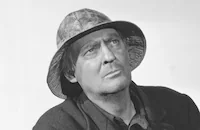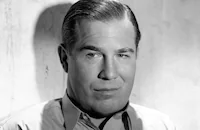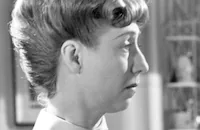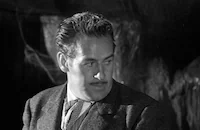Dr. Gillespie's Criminal Case

Brief Synopsis
Cast & Crew
Willis Goldbeck
Lionel Barrymore
Van Johnson
Keye Luke
Alma Kruger
Nat Pendleton
Film Details
Technical Specs

Synopsis
One year after her former fiancé, Roy Todwell, was sentenced to life in prison for murder, socialite Marcia Bradburn goes to visit Dr. Leonard Gillespie. The wheelchair-bound Gillespie, who lives and works at New York City's Blair General Hospital, testified unsuccessfully at Roy's trial, hoping to convince the jury that Roy was insane and should be put in a sanitarium. Marcia wants to accept the proposal of Sergeant Patrick J. Orisin, but is afraid that if Roy reads about it in the newspaper, he will react violently. Gillespie tells her not to worry, but after she leaves, he telephones Warden Kenneson at the penitentiary where Roy is incarcerated and says that he will be flying in for a visit. Gillespie is currently searching for a new chief assistant and encourages an intense rivalry between the two candidates, Randall "Red" Adams who wants to join the Army medical corps, and Brooklyn-born Chinese American Lee Wong How, who is learning Chinese in the hope of going to China. One of Lee's patients is Alvin F. Peterson, a young man who lost both legs in the attack on Pearl Harbor. Lee tells Peterson that a special operation to put on artificial limbs is going to be performed on him. The uninterested and embittered Peterson has been burning unread letters from his girl friend, and Gillespie advises Lee and head nurse Molly Byrd never to leave the extremely depressed Peterson alone. On Friday evening, after interrupting Red's romantic date with wealthy social services worker Ruth Edly, Gillespie takes Red with him to the penitentiary, in the hope of convincing the warden to transfer Roy to a sanitarium. The warden lets Gillespie go to the prison hospital, where Roy works, and Roy cheerfully tells him that he remembers nothing of his earlier violent episodes. Despite Roy's demeanor, Gillespie is convinced that the young man is still dangerously insane. Back at the hospital, Gillespie and Lee try to get Peterson to walk on his new limbs, but he refuses to cooperate. Gillespie, who has gotten hold of a letter from Peterson's girl friend, gives him the letter, which confirms that she still loves him. Just then, chief administrator Dr. Walter Carew announces that there is a terrible infection in the children's post-surgical ward, and Gillespie assigns Red and Lee to the case. The doctors use every means at their disposal to reduce the girls' fevers, and Lee and Red even resort to hours of flapping ice-cold sheets on one child, Margaret, who is near death. Their joint effort makes them realize that they are more friends than rivals. One of the nurses, Miss Dodd, dies from the same fever, but Margaret eventually recovers. A short time later, Marcia brings Gillespie a letter that Roy sent to her, and Gillespie immediately travels to the penitentiary. Meanwhile, Lee brings a visitor to Peterson, Mr. Coleman, a wealthy friend of Gillespie who secretly paid for Peterson's operation. When Coleman reveals that he lost his legs in an accident but has gotten by very well with artificial limbs, Peterson is inspired and determines to learn to walk. At the penitentiary, Gillespie argues Roy's case in front of the prison board, explaining that he is a "timebomb." A board member then points out that Roy, whose violence had supposedly been triggered by shrill noises, has not reacted at all to the daily prison whistles and therefore must be faking. Just at that moment, however, as Roy reads about Marcia's engagement, the noon whistle blows and his mind snaps. With two accomplices, Roy goes to the warden's office with smuggled guns and kills a board member. The three convicts then exchange clothes with some board members, take them hostage and leave through the prison gate. After the convicts escape, the police slowly approach the deserted cabin in which they are hiding and Gillespie calls out to Roy, telling him that he is still insane because he never remembers his crimes. After taking the other prisoners' guns, Roy leaves the shack and shoots wildly, but is killed by the police. Some weeks later, Red goes to Ruth's apartment for their long-awaited date, but finds that Gillespie, Lee and other hospital staff members are there, along with the surviving fever patients, Marcia, her new husband and a now ambulatory Peterson.

Director
Willis Goldbeck
Cast

Lionel Barrymore

Van Johnson

Keye Luke
Alma Kruger

Nat Pendleton

Margaret O'brien

Donna Reed

John Craven
Michael Duane

William Lundigan

Walter Kingsford

Marilyn Maxwell

Henry O'neill

Marie Blake

Frances Rafferty
Nell Craig
Arthur Loft
Milton Kibbee
Robert E. O'connor
Boyd Davis
Richard Crane
Aileen Pringle
Edna Holland
Lorin Raker
Richard Bartell
Katharine Booth
William Haade

Ralph Dunn

Roy Barcroft

Lee Phelps
Capt. Somers

Douglas Fowley
Barbara Bedford
Patricia Barker
Janet Chapman

Yvette Duguay
Irene Tedrow
Herbert Vigran
Gertrude W. Hoffman

Byron Foulger

George Irving
John Dilson
Matt Moore

Edward Keane
Edward Earle

Grant Withers
George Lynn
Ted Adams
Jerry Jerome
Chick Collins
Don Cadell
Helen Dickson
Marianne Quon
Almeda Fowler
Margaret Adden
Crew
Daniele Amfitheatrof
Lawrence P. Bachmann
Martin Berkeley
Edward G. Boyle
Norbert Brodine
William Ferrari
Cedric Gibbons
Frank Hull
Irene
Charles Lawton
Al Raboch
Harry Ruskin
Douglas Shearer
Edwin B. Willis

Film Details
Technical Specs

Articles
Dr. Gillespie's Criminal Case
Reed was hardly in contention for a long-running role in the series, whose main characters were all members of the hospital staff, but her return was a sign of MGM's investment in her future. The film's trailer even listed her as one of the picture's "Stars of Tomorrow," appropriately placing her after Margaret O'Brien, who had already created a big stir in the World War II refugee drama Journey for Margaret (1942) and Van Johnson, who was just a few pictures away from his breakthrough role in A Guy Named Joe (1943).
The "Dr Kildare" series had been a money-maker for MGM ever since they bought the rights to Max Brand's characters from Paramount, which had made the first Kildare film in 1937, starring Joel McCrea (opposite Barbara Stanwyck) in Internes Can't Take Money. The official series bow was 1938's Young Dr. Kildare, which presented Lew Ayres in the title role and added his crusty mentor, Dr. Gillespie, played by Lionel Barrymore. Other regular cast members in the first film included Marie Blake as Sally, the hospital's talkative switchboard operator, Walter Kingsford as hospital head Dr. Carew and Nat Pendleton as dimwitted ambulance driver Joe Wayman. Later additions would include head nurse Alma Kruger and social worker Larraine Day, who would become Ayres' love interest until her death, right after their wedding. When Ayres announced that he was a conscientious objector at the start of World War II, MGM had to withdraw Dr. Kildare's Victory (1942) from distribution and cut him from the series. In his place Barrymore acquired two new interns, Van Johnson as Randall "Red" Adams and Keye Luke as Dr. Lee Wong How. All of the late series regulars would appear in Dr. Gillespie's Criminal Case.
The behind-the-camera talent were also familiar with the formula. Director Willis Goldbeck had written all 11 earlier entries before moving into the director's chair with the previous outing, Dr. Gillespie's New Assistant (1942). Of the three writers, Harry Ruskin had co-written all of the earlier films with Goldbeck and Lawrence P. Bachmann had contributed to several Kildare films. Only Martin Berkeley was new to the series, and he would return for 3 Men in White in 1944.
The premise of Reed's second outing in the series revolved around her character's desire to get married and her concern that news of her plans would cause trouble with her former love, now in prison despite Barrymore's urgings that he be sent to a mental health institution. As in other series entries, that was just one plot thread. In addition, Johnson tries to make time for a date with pretty social worker Marilyn Maxwell (in her fourth MGM film and the start of a recurring role in the series), Luke deals with an embittered soldier (William Lundigan) wounded at Pearl Harbor and both team up to deal with an outbreak of infection in the post-surgical ward that almost claims the life of a young patient (Margaret O'Brien). The main focus at this point, however, was Barrymore's Dr. Gillespie, as evidenced by the title. Working titles included Dr. Gillespie's Prison Story and Dr. Gillespie's Criminal Story.
Director: Willis Goldbeck
Screenplay: Lawrence P. Bachmann, Martin Berkeley, Harry Ruskin
Cinematography: Norbert Brodine
Art Direction: Cedric Gibbons
Music: Daniele Amfitheatrof
Cast: Lionel Barrymore (Dr. Leonard B. Gillespie), Van Johnson (Dr. Randall 'Red' Adams), Keye Luke (Dr. Lee Wong How), Alma Kruger (Molly Byrd), John Craven (Roy Todwell), Nat Pendleton (Joe Wayman), Margaret O'Brien (Margaret), Donna Reed (Marcia Bradburn), William Lundigan (Alvin F. Peterson), Marilyn Maxwell (Ruth Edly), Henry O'Neill (Warden Kenneson), Marie Blake (Sally), Frances Rafferty (Irene), Bryan Foulger (Father), George Irving (Rear Admiral), Milton Kibbee (Briggs), Aileen Pringle (Chaperon), Irene Tedrow (Nurse Katherine Dodd), Herb Vigran (Orderly), Grant Withers (Waddy).
by Frank Miller

Dr. Gillespie's Criminal Case
TCM Remembers Van Johnson - Important Schedule Change on TCM In Honor To Salute VAN JOHNSON
The new schedule for the evening of Tuesday, December 23rd will be:
8:00 PM In the Good Old Summertime
9:45 PM A Guy Named Joe
12:30 AM Thirty Seconds Over Tokyo
2:30 AM The Last Time I Saw Paris
4:30 AM Thrill of a Romance
Van Johnson (1916-2008)
Van Johnson, the boyish leading man whose clean cut, All-American appeal made him a top box-office draw for MGM during World War II, died on December 12 in Nyack, New York of natural causes. He was 92.
He was born Charles Van Dell Johnson on August 25, 1916, in Newport, Rhode Island. By his own account, his early childhood wasn't a stable one. His mother abandoned him when he was just three and his Swedish-born father offered little consolation or nurturing while he was growing up. Not surprisingly, Johnson found solace in singing and dancing lessons, and throughout his adolescence, he longed for a life in show business. After graduating high school in 1934, he relocated to New York City and was soon performing as a chorus boy on Broadway in shows such as New Faces of 1936 and eventually as an understudy in Rodgers and Hart's musical, Too Many Girls in 1939.
Johnson eventually made his way to Hollywood and landed an unbilled debut in the film version of Too Many Girls (1940). By 1941, he signed a brief contract with Warner Bros., but it only earned him a lead in a "B" programmer Murder in the Big House (1941); his contract soon expired and he was dropped by the studio. Johnson was on his way back to New York, but as luck would have it - in the truest Hollywood sense - friends Lucille Ball and Desi Arnaz introduced him to Billy Grady, a lead talent scout at MGM, which was currently Ball's new studio. Johnson was signed up and almost immediately MGM had a star on its hands.
It might have been slow going at first, with Johnson playing able support in films such as Dr. Gillespie's New Assistant and The War Against Mrs. Hadley (both 1942). By 1943 the studio capitalized on his broad smile and freckles and starred him in two of the studio's biggest hits: A Guy Named Joe and The Human Comedy. Those two films transformed him into a boxoffice draw with a huge following, particularly among teenage girls. A near fatal car accident that same year only accentuated the loyalty of his fans, and his 4-F status as the result of that accident created an opportunity for him when so many other leading actors of the era (James Stewart, Clark Gable) were off to war. Johnson was quickly promoted as MGM'sleading man in war heroics and sweet romancers on the big screen: The White Cliffs of Dover, Thirty Seconds Over Tokyo (both 1944), Thrill of a Romance, the episodic Week-End at the Waldorf (both 1945), and a musical remake of Libeled Lady entitled Easy to Wed (1946).
Hits though these were, it wasn't until after the war that Johnson began to receive more dramatic parts and better material such as supporting Katharine Hepburn and Spencer Tracy in the political farce State of the Union (1948). other significant roles included the well-modulated noir thriller The Scene of the Crime, the grim war spectacle Battleground (both 1949), the moving domestic drama Invitation (1952) in which he played a man who is paid to marry a woman (Dorothy McGuire) by her father. Before he left MGM, he closed his career out in fine form with the sweeping musical Brigadoon, co-starring Gene Kelly and Cyd Charisse; and the lilting soaper The Last Time I Saw Paris (both 1954) with Elizabeth Taylor.
After he left MGM, the parts that came Johnson's way weren't as varied, but he had his moments in The Caine Mutiny (1954), the beguiling romance drama Miracle in the Rain (1956) with Jane Wyman; and his lead performance in one of the first successful made for-TV-movies The Pied Piper of Hamelin (1957). By the '60s, Johnson returned to the stage, and played the title role in London's West End production of The Music Man. He then returned to Broadway in the drama Come on Strong. He still had a few good supporting parts, most notably as Debbie Reynolds' suitor in Norman Lear's scathing satire on marital differences Divorce American Style (1967); and television welcomed his presence on many popular shows in the '70s and '80s such as Maude, Fantasy Island, The Love Boat and of course Murder She Wrote. There was one last graceful cameo in Woody Allen's The Purple Rose of Cairo (1985), yet for the most remainder of his career, Johnson worked mainly on the dinner theater circuit before retiring from showbiz completely by the mid-90s. He is survived by a daughter, Schuyler.
by Michael T. Toole
TCM Remembers Van Johnson - Important Schedule Change on TCM In Honor To Salute VAN JOHNSON
Quotes
Trivia
Notes
Working titles of the film were Dr. Gillespie's Prison Story and Dr. Gillespie's Criminal Story. The characters of "Marcia Bradburn" and "Roy Todwell" had previously appeared in the film Calling Dr. Gillespie, although in the earlier film, actor Phil Brown had portrayed Roy. Actress Katharine Booth made her motion picture debut in the film. Hollywood Reporter news items include William G. Fisher, Betty Jean Nichols, Jeanette Alice Winkler, Diane Toien, Geraldine Pinker and Marion Salerno in the cast, but their appearance in the released film has not been confirmed. The Variety review incorrectly identified the film's editor as Laurie Vejar. For additional information on the Dr. Gillespie series, see the entry above for Calling Dr. Gillespie and the entry for Young Dr. Kildare in AFI Catalog of Feature Films, 1931-40; F3.5251, and consult the Series Index.















